
Image from ultimatemusictheory.com
About 1000AD,
The modern five-line staff was first adopted in France, and became widely used by the 1500s.
"Ut" was changed in the 1600s in Italy to the open syllable "Do", at the suggestion of the musicologue
In Norwich England, Si was changed to Ti by Sarah Glover in an instructional book published in 1835, so that every syllable might begin with a different letter.
Finally, in the Sound of Music in 1959 Julie Andrews sang that famous "
The Treble, Violin or G clef for high notes, the Bass or F clef for low notes, and Five C clefs in the middle. Note, the word "clef" comes from the Latin word "clavus" meaning a "key".

The following extract is from makingmusicmag.com
To indicate the pitch and order of notes on a staff, the clef was invented. Three clefs exist for the tones G, F, and C. Hence their names – G-clef, F-clef, and C-clef – and shapes, which are an elaborate version of each letter. Where each clef is written also indicates its tone. The G-clef, or treble clef, curls around the G line in a treble staff, whereas the two dots of the F-clef, or the bass clef, are bisected by the F line. The C-clef (today) is used in two positions and therefore has two names. When it’s an alto clef, the note C is on the staff’s third line; when it’s a tenor clef, the C is on the fourth line.
In music that predates the eighteenth century, many more clefs can be found. Or rather, the three basic clefs were repositioned to indicate a different staff and order of notes.
**End of Extract
Note too that before the printing press in 1453, the treble and bass clefs took on various shapes, afterwards they became standardized with the shapes we know today.
By 1320, the Maxima, the Longa, the Brevis, the Semibrevis, and the later Minima note shapes had been developed, referred to as Franconian notation, and promoted by
After about 1450 and the invention of the printing press, musical notes took on hollow shapes ("white notation") reserving black shapes only for the smallest note values. It coupled with the change from parchment to paper with paper less suited to holding large dots of ink. But new smaller notes were added, and what was earlier the shortest of all notes used, the semibreve, has become the longest note used routinely today.
| Latin | Notes and Rest | British (Aussie) English | US English | German/Austria | French | Italian | Spanish |
|---|---|---|---|---|---|---|---|
| Maxima |  | No Longer in Use | |||||
| Longa | 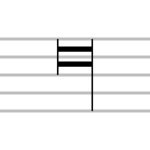 | No Longer in Use | |||||
| Brevis |  | Breve | Double Whole Note | Doppelganzenote | Carrée | Breve | Breve |
| Semibrevis | 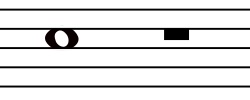 | Semibreve | Whole Note | Ganzenote Dutch: Helenoot | Ronde | Semibreve | Redonda |
| Minima |  | Minim initially a black note | Half Note | Halbenote | Blanche White note | Minima or Bianca | Blanca |
| Semiminima or c.1450 Semiminima Major | 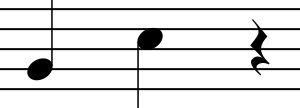 | Crotchet or Greater Half-Minim c.1350 a hooked black note, then a hooked hollow note, finally c.1450 a black note no hook | Quarter Note | Viertelnote Dutch: Kwartnoot | Noire Black note | Semiminima or Nera | Negra |
| Semiminima Minor or Fusa | 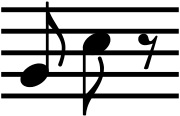 | Quaver Initially called a Crotchet or Lesser Half-minim, from c.1560 called a Quaver | Eighth Note | Achtelnote | Croche Hooked note | Croma coloured red in early notation | Corchea |
| Semifusa c.1500 | 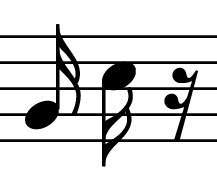 | SemiQuaver | Sixteenth Note | Sechzehntelnote | Double Croche | Semicroma | Semicorchea |
 | DemiSemiQuaver | Thirty-second Note | Zweiunddreissigstelnote | Triple Croche | Biscroma | Fusa | |
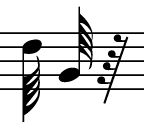 | HemiDemiSemiQuaver | Sixty-Fourth Note | Vierundsechzigstelnote | Quadruple Croche | Semibiscroma | Semifusa | |
In the 1600s, Time Signatures as we know them today, and Bar Lines arrive

Frequently encountered types of metre
Click here for the Wikipedia article on Beat (music) that includes simple definitions on
The downbeat is the first beat of the bar, i.e. number 1. The upbeat is the last beat in the previous bar which immediately precedes, and hence anticipates, the downbeat. Both terms correspond to the direction taken by the hand of a conductor.
In much popular music 4
4 time, counted as "1 2 3 4, 1 2 3 4...", the first beat of the bar (downbeat) is usually the strongest accent in the melody and the likeliest place for a chord change, the third is the next strongest: these are "on" beats. The second and fourth are weaker—the "off-beats". Subdivisions (like eighth notes) that fall between the pulse beats are even weaker and these, if used frequently in a rhythm, can also make it "off-beat".
 A backbeat, is a syncopated accentuation on the "off" beat. In a simple 4
A backbeat, is a syncopated accentuation on the "off" beat. In a simple 4
4 rhythm these are beats 2 and 4 as seen in the displayed image, popular on the snare drum.
A rhythm in which the regular pattern of accents of the prevailing metre is contradicted by a conflicting pattern and not merely a momentary displacement that leaves the prevailing metre fundamentally unchallenged.
An example of counterpoint rhythm can be heard in the 1976 classic "Go your own Way"  click here. Lindsey Buckingham's "rogue" vocal continually pulls against the metre, coupled with a background guitar track he added late into production. While he felt that the acoustic guitar "glued the whole piece together" its unusual entrance creates listener confusion over the actual location of "beat one", and then as a "real life" song about relationship breakdowns it became one of their biggest hits.
click here. Lindsey Buckingham's "rogue" vocal continually pulls against the metre, coupled with a background guitar track he added late into production. While he felt that the acoustic guitar "glued the whole piece together" its unusual entrance creates listener confusion over the actual location of "beat one", and then as a "real life" song about relationship breakdowns it became one of their biggest hits.
Prior to 1600 it was called "Perfect Time" and used a complete circle as its mensuration (time signature) sign
Typical metre of much popular music prior to the 20th Century e.g. Gilbert and Sullivan
Prior to 1600 it was called Imperfect Time which used a semi-circle  as its mensuration sign
as its mensuration sign
Today  represents 4
represents 4
4 time with that "C" now short for "Common time"
An associated time signature with a vertical line through it  represents 2
represents 2
2 time, also known as "Cut time"
Prior to 1600 it was called "alla breve" or "tempus imperfectum diminutum" – to be played twice as fast as normal Imperfect Time
Click here for more details on history prior to 1600
The following remarks are extracted from quora.com
What-is-the-difference-between-4-4-time-and-2-2-time-and-how-does-this-affect-the-music?
Rob Weir, Classical music radio host 1989-1991
4
4 tends to have a secondary accent on the 3rd beat, along with the primary accent on the 1st beat. 2
2 would only have the primary accent.
Simon Parker, Engineer, Dad, Musician, Beginner Composer
Upvoted by Ethan Hein, music technology and music education professor
Expanding slightly on Rob's spot on answer:
It's all in the emphasis on the beats.
As a rule of thumb:
Quadruple time: e.g. 4
4 12
8 is Strong - Weak - Medium - Weak
Duple time: e.g. 2
4 2
2 6
8 is Strong - Weak
Triple time: e.g. 3
4 9
8 is Strong - Weak - Weak
** End of extract
** End of Page